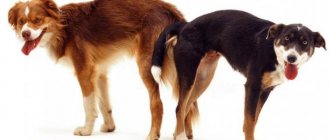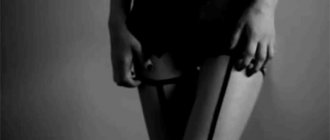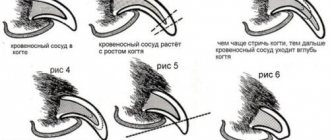Not all dog breeders prefer to sterilize their pets in order to terminate the birth. This is especially true for owners of purebred dogs, whose breeding can provide the breeder with considerable profit. In this case, it becomes necessary to breed the animal, which raises a lot of questions for inexperienced dog breeders. One of these is why dogs stick together when mating, how safe it is, and what owners should do at this moment.
How does the mating process occur?
As a rule, after mating, the male quickly disconnects from the female at the end of sexual intercourse. This is typical for most living things, but can cause some difficulties in dogs. Animals stick their butts together not out of their own whim, but because of their specific anatomy. To know the functionality of this position, one should turn to the physiology of the process itself.
Difficulties with separation are typical for wolves and foxes, which are close relatives of dogs.
Getting to know the dogs begins with sniffing. This way the animals can decide how suitable they are for each other. If at this stage both have shown sympathy, then preparations for mating begin. Experienced breeders call it a trial cage. The female chooses a suitable position, the male is on top. His hind legs are firmly on the ground, and he clasps his partner with his front legs.
If mounting is successful, the male's penis increases in size and enters the female's vagina. At this time, the dog’s vaginal muscles tense, which contributes to a strong girth of the penis. This process is called gluing. The result is a doggy knot: a lock that prevents the male's penis from accidentally popping out before intercourse is complete. The male gets stuck in the female's vagina. From the outside it seems that the animals are literally glued to each other.
The decisive moment is when the dog's pace accelerates, after which ejaculation occurs. After this, nothing usually happens, as male dogs have a rest period lasting about 5 minutes. At this time, the partner often tries to change her position, lie down or sit down. The owner should hold the dog so that it does not run away while the male is resting.
The male changes the mounting position to a more comfortable one, throwing his paws to the other side. As a result, animals that are stuck together turn their backs to each other, waiting for the moment of separation. At this time, ejaculation does not stop, sperm enters the female’s vagina.
Thus, schematically, the entire knitting can be divided into several stages:
- Preparation. At this stage, a lubricant is released, which helps the male to easily penetrate the bitch’s vagina. It forms immediately after the start of sexual intercourse.
- Pairing. The penis becomes larger, its bulb increases as much as possible. During mating, a secretion of no more than 3 ml is released.
- Ejaculation. It lasts about a minute, after which the dog begins to relax. At this stage, dogs usually bond.
Such a knot in dogs can last for quite a long time: from 5 to 30 minutes, which is a normal physiological process.
The last stage is considered the most important and can be especially stressful for new breeders, as the dog usually begins to whine and try to detach from the male. Many dog breeders do not know what to do in such a situation; they want to unhook the dogs, which is absolutely forbidden to do.
Why do you need a hitch?
Animals that cannot disentangle themselves find themselves in a very vulnerable position. Dogs stuck together remain defenseless against potential dangers. But such a mechanism is due to evolutionary necessity, because each stage of mating is aimed at successful conception. This lock helps sperm quickly enter the female’s vagina, and the tight fusion prevents it from leaking out of the genital tract. This situation is also beneficial for the males themselves: it allows them to keep their partners from mating with their competitors longer.
How to behave as owners
Not only dogs, but also owners should prepare for the mating process. They should not only consult with a veterinarian about the general condition of the pet, but also consult with a dog handler about their own behavior in a given situation. Even with an unplanned mating, the owner must remain calm and cool, and try to think soberly.
Even if your pet got into a “lock” with an unwanted male, which happened entirely through your fault, under no circumstances should you forcibly separate them. Firstly, physically this is practically impossible; secondly, the pet can be injured so severely that the outcome can be quite disastrous for the female’s health.
The planned mating must take place under the full control of the owners, preferably the presence of an experienced specialist.
Their presence should be unnoticed and intervention is permissible only when certain difficulties arise: aggression on the part of the female, reluctance to give in to the male, etc. The owners must behave calmly and confidently so that their nervousness is not transmitted to their pets. In addition, you should avoid any other irritants during the process.
In any case, it is worth interfering with natural processes only if something obviously goes wrong.
Hello, dear readers!
In the whole world there is no more obedient and loyal animal than a dog. Every day there are more and more dog breeders who are happy to get acquainted with the daily life of their four-legged friend. All owners sooner or later encounter such a phenomenon as gluing, during which the mongrels are tightly glued together with their butts.
What to do in such a situation? Does it hurt dogs during mating and do they need to be separated?
You will find answers to all of the above questions in our article.
Choosing the right partner
Some clubs that practice linear breeding techniques can provide assistance in finding a partner, but only if the dog breeder and his pet are members. Sometimes the rules of the organization require mandatory breeding of registered dogs, aimed at preserving the purity of the breed. At the same time, the owner of the bitch has the privilege of choosing “gentlemen”, since caring for the animal during pregnancy and after childbirth falls on his shoulders.
You can also cooperate with private breeders, but here it is important not only to see the pedigree confirming that the partner is not an outbred mestizo, but also the applicant himself. This is necessary in order not to get a “pig in a poke” in the form of breeds that do not meet the standards. In addition, if both dogs have any minor defects, then they must be different so that the genes responsible for them do not appear in a dominant form in future offspring.
It is very important to pay attention to the partner’s owners, since it is with them that the deal will be concluded and the formalities will be settled. Breeders are required to provide a veterinary passport and pedigree of the pet, as well as draw up an agreement with specified conditions before breeding animals.
The services of purebred males that meet all breed standards are always paid. They usually cost the same as the sale price of the puppy, and the contract specifies how payment will be made. Sometimes puppies act as her.
Unfortunately, there are cases when unscrupulous owners skip the formal stage and voice their conditions after mating. Naturally, their essence is a one-sided benefit, so you should avoid divorcers who postpone the official conclusion of the deal or offer to negotiate verbally.
Advice from experienced people
- You should not breed a female less than 2.5 years old and a male less than 1.5 years old;
- The first mating is best done in autumn or winter;
- Before the first mating, it is necessary to conduct a full examination of the dogs, clean them from fleas and worms (at least 10 days before mating);
- All vaccinations for the female must be done in advance (1 month before mating);
- It is imperative to introduce the dogs before the first mating (it is better to hold regular meetings);
- Under no circumstances should you interfere or force the dogs, everything will happen by itself;
- If the female is nervous about mating, reassure her;
- For better results, it is necessary to re-mate a couple of days after the first.
Preparation for mating
A month before the planned mating, the dog needs to get rid of worms and make sure that the vaccinations do not expire by the end of lactation. If the date of the next vaccination, for example, falls on the due date, vaccinations should be done earlier, 3-4 weeks before mating.
It is advisable to check dogs for diseases that are sexually transmitted through contact, as well as those that may cause early abortions:
- transmissible venereal sarcoma;
- gonococcal urethritis;
- chlamydia;
- brucellosis;
- Escherichiosis;
- staphylococcal and streptococcal infection;
- mycoplasmosis.
Should I intervene?
Not all breeders know what to do in a dog breeding situation. Should animals be posted? Dog handlers and veterinarians say a categorical “no.” Experienced breeders continue to observe and control the process.
Even if the knot in dogs does not weaken for more than half an hour, you cannot apply physical force to the couple. You need to help the female if she breaks out of the “lock”. The zealous “bride” is calmed down. Sometimes the loin is held to direct the flow of sperm to the uterus. This is necessary when the female is smaller than her lover. They also help a male dog if he is unable to stand with his back to his partner after ejaculation. The dogs are not allowed to twitch.
Important! Animals are not forcibly separated, even if mating is not planned. This is fraught with injury and loss of animal health.
Young ladies get scared, the spasm can intensify to unbearable pain. In the future, they are afraid of partners and intercourse. Sexual intercourse can take even longer.
During intercourse, owners create a calm environment for the dogs. Before mating, the female is fed moderately; it is better not to feed the male at all. The couple is given the opportunity to walk around and run around. The process is best done in the evening or early in the morning. The male feels more confident in his own territory, so the “brides” are brought to his home. It is better if the sacrament of conception occurs in silence. They watch him from the side, not trying to separate the couple.
The first mating is often carried out with a muzzle.
The first mating of a young bitch is especially important. She can be aggressive. Often the act is carried out wearing muzzles. The suitable age for dogs is 2-2.5 years. Matings earlier than this period lead to unhealthy litters, and the physical condition of the parents is also at risk. Bitches are bred after the third heat.
The best time for pets to crossbreed is late autumn and winter. Puppies are born healthier. The hormonal surge during early mating slows down the growth of dogs. The timing of puberty is individual and depends on the size of the individual, breed, and psychological state.
Important! If mating does not occur during intercourse, a repeat control mating is carried out after 2-3 days while the bitch is in heat.
First time
Where and how 1 male is mated. Many will agree that it is better to do it at home. Arrange with the owner of the bitch to come to your home with the pet at a certain time. You need to know in advance when mating will take place. How to properly prepare your dog for this action? Before starting the “procedure”, you should take a walk down the street with your pet, who will soon become a “father”. This will also increase activity and interest in upcoming events. It is not recommended to feed the dog heavily before the first mating; you should eat no earlier than two hours before mating. The best option is to give your dog something to eat before going for a walk.
There is also an opinion that it is the first mating of a male that should take place with an experienced female, which is better to choose for the first mating. It is better if the female herself wants to mate and behaves calmly.
Dog mating process
After the dogs have sniffed and found out that they are suitable for each other, the bitch takes a suitable stance , and the male climbs on her, holding her tightly with his front paws and resting his hind legs on the ground. These actions of a male dog in the language of dog handlers are called “trial or fitting cages.” Why this name? The male and female are trying to find the optimal position, and the partner is also looking for the entrance to the female’s vagina. After successful completion of the fitting cages, the male enters the vagina - and the penis emerges from the prepuce (a fold of skin that covers the head of the penis), increasing in size several times. The bulb of the head of the penis also enlarges - it becomes somewhat thicker than the male penis.
In turn, the bitch tenses her muscles, which clamp the vagina and tightly grasp the partner’s penis behind the bulb of the head. And since the bulb is thicker than the penis, it turns out to be a kind of lock that prevents the “groom’s” penis from jumping out of the “bride’s” vagina. This is how gluing happens.
At this time, the male's movements become more frequent - this mating period lasts from 30 to 60 seconds. This is the most important part of mating , since it is at this time that the male ejaculates.
After ejaculation, the male begins a period of relaxation - the male leans on the bitch and can remain in this position for up to 5 minutes. At this time, the bitch experiences extreme excitement, which is clearly manifested in her behavior - she squeaks, whines, tries to sit down or even lie down. In order to prevent her from leaving under the dog, the owner must hold the bitch until the dog has rested and is ready to change position.
If dogs do not move into a natural mating position (tail to tail), then they need help with this - after all, standing in the lock can last quite a long time, and the dogs can get tired, being in an uncomfortable position, and break the lock ahead of time. Important! Under no circumstances should dogs be disturbed while they are in the lock position. You can only hold them carefully so that they do not make sudden movements. Why doesn't mating occur during every dog mating? This can be explained by the following reasons:
- medical problems in a male dog;
- medical problems in the bitch;
- inexperience of partners;
- the bitch is not ready to mate (an inappropriate day of heat was chosen for mating).
Optimal period
There is no specific fertile period for bitches of all breeds. If we take the average indicators, then this is 11-12 days from the start of bleeding. The owner should be more attentive to the behavior of the pet so as not to make mistakes in the calculations, especially during the first mating. In subsequent times, the favorable days will be the same as the first time.
Show ring for dogs: what is it and what is it for?
As a guide, you need to remember that when:
- in a cycle of 21-23 days, fertilization is possible from 10 to 14 days;
- cycle of 26-28 days - from 14 to 18 days.
Attention! Regardless of the breed and size of the animal, conception can occur even on the eighth day of the cycle.
What does it mean when a dog is ready for mating?
When mating animal dogs, only the readiness of the female matters. Males are ready all year round and around the clock; very rare dates have a bad effect on the character of the pet.
bitch in heat
The bitch’s attitude towards accepting her partner’s advances can be understood by:
- clear discharge from the genital opening (vulva);
- changing the appearance of the loop;
- the pet’s reaction to touching its back - it bends;
- pulling the tail to the side if you touch its base.
We must remember ! A dog ready to copulate is absolutely promiscuous. Any stray sexually mature male can become the father of future offspring.
The role of mating in the fertilization of a bitch
For some reason, many people think that during the mating process, a male dog releases only sperm. This is a misconception - during sexual intercourse, a male dog secretes three types of secretions:
- In the first stage, lubricant is released.
- In the second stage, sperm is released.
- At the last third stage, which occurs only during mating, secretions of the prostate gland are released.
Let's look at each stage in more detail.
First stage
This stage can be called preparatory. The male excretes the first portion of fluid almost immediately after entering the female’s vagina. There are no sperm in this portion - it is a clear liquid that is needed for lubrication.
Second stage
This is the most important stage during which the male dog secretes a fluid (ejaculate) containing sperm. The second stage occurs after the penis is already sufficiently erect and its bulb has reached its maximum width. The volume of secretion is very small - only 2-3 ml, but it is with this portion that the male releases all the sperm - up to 600 million per 1 ml of ejaculate.
So, it turns out that conception can occur without mating. But it’s not for nothing that nature created the “lock” mechanism.
Third stage
This is the last stage in dog mating, during which the male secretes prostate secretions with a volume of up to 80 ml. These secretions speed up the movement of sperm on their way to the bitch's uterus.
Important question
So, you are faced with the task: to untie or not? It's worth weighing the pros and cons. Consider whether you can provide your dog with regular mating. If the answer is yes, then you can untie it. Otherwise, there may be consequences - the male will rush to every bitch, his behavior will be disobedient, and it will be difficult to train. It is also worth remembering that male dogs must have a permanent mating partner. Before mating, it is necessary to do an examination and take tests for both partners. Remember that you are also obliged to provide comfortable conditions for the future offspring that will result from the mating of two dogs.
Process Features
The reproduction of new life is not called a miracle for nothing. Just think, from the waste products of two animals of different sexes, another living creature is obtained. In this case, the offspring inherits the DNA of their parents: appearance, character, abilities, diseases. One of the important components of breeding work is mating.
Any novice breeder should understand all the intricacies of this process. Let's figure out why dogs stick together when mating.
Dogs have accompanied humans for more than 10 thousand years, and every year the number of four-legged animals is only growing. Chaotic reproduction of stray animals is a separate and very complex issue, but we will talk about breeding work - obtaining offspring from dogs that have pedigree and breed value.
A novice breeder must understand that choosing a partner, planning a mating and the process of mating dogs itself are all little details. Berries will begin during gestation and after the puppies are born.
Be prepared to fully surrender to the process, cope with difficulties and dangers. Be prepared to stay awake at night and give all your strength and care to the mother dog and puppies.
If you are not ready for such sacrifices or think that this will not affect you, it is better not to get involved in breeding activities and sterilize your pet for its own good.
The average age at which a dog becomes sexually mature ranges from 9–17 months. However, some large and giant dogs are ready to mate only at 2–3 years of age.
Bitches are traditionally bred at the onset of their third full heat, and males at the age of 1–1.5 years.
The timing may vary, since mating is contraindicated for dogs whose bones or psyche are not fully formed.
Mating is possible only when the bitch is ready. The favorable period usually occurs on the 11th–12th day of estrus. It is advisable that the partners know each other, that is, the meeting at mating was not the first.
The male senses the female’s readiness for mating even before mutual sniffing.
During sniffing, both partners are convinced of their intentions, and the bitch finally decides whether the male is worthy to reproduce with her.
Within 4–5 minutes, if everything goes well, the bitch takes the optimal position for mating, and the male moisturizes the female’s vagina with a special lubricant. Mating will not be successful if the dog’s arousal is low, and this is possible if:
- The female is not ready to mate or has no obvious scent.
- The situation seems dangerous to the dogs.
- The dog has health problems.
The first stage is over, then mating follows. The male's movements become sharper and rougher, he firmly holds the female with his front paws. The male penis quickly increases in size by about 4 times. When erect, the head is larger and wider than the penis itself.
When the penis is in a fully erect state, the female tenses the muscles of the vagina and, as it were, squeezes the male's penis. This ensures that the male's penis will not slip out at the most crucial moment.
This is how the second stage takes place, it is called gluing (from the word pincers).
Dogs stick together during third stage mating. The male ejaculates and lasts about a minute.
The success of mating and multiple pregnancy directly depends on the amount of seminal fluid received for its intended purpose. During ejaculation, the male experiences relaxation, and he hangs on the female.
Usually at this stage, inexperienced breeders become confused and do not know what to do. The only help you can provide is moral support.
Ideally, the dogs themselves should take the mating position - the male throws himself over the bitch and stands with his butt towards her. If this does not happen, the bitch is calmed down, and the dog is helped to take the desired position.
Next, it is better to make sure that the bitch and the dog do not twitch or try to come apart. This stage lasts up to 6–10 minutes and is called the lock.
Dogs do not mate for pleasure; mating has only one purpose - fertilization. The main stage of mating, on which its success depends, is ejaculation. The total volume of semen ranges from 2–3 ml. Such a small amount of seminal fluid contains up to 2,000 sperm.
To speed up the movement of seminal fluid to the eggs, a special secretion begins to be released from the male penis; this process takes 6–10 minutes.
In total, in addition to sperm, about 80 ml of prostate secretions are injected into the female’s vagina.
Locking or gluing is a natural process whose purpose is:
- Successful fertilization.
- A guarantee that the female will not be impregnated by another male.
Few people know, but if a female mates several times in a row with different males, her offspring may have different fathers; also, puppies may be born at different stages of term if the female bred for several days in a row. While in the female's vagina, the male's sperm can remain alive and mobile for up to 7 days.
In rare cases, mating does not result in a lock. Statistically, such a mating is considered unsuccessful, although the bitch can become pregnant.
The lock fails if:
- A young female or male is mating - the reason is inexperience and stress.
- Partners have pathologies, including the reproductive system.
- The timing was wrong for mating.
The choice of the optimal time for mating depends on the individuality of the bitch, or more precisely, on her cycle. Mating occurs after the onset of the third heat, so the owner needs to calculate based on the following data:
- The first two heats lasted 21–23 days, which means you need to breed from the 10th to 14th day of the heat.
- The first two heats lasted 26–28 days, which means you need to breed from the 14th to 18th day of the heat.
The environment in which mating takes place plays a significant role. It is better that the mating takes place in the dog’s territory and without prying eyes. A bitch, especially a young one, will not allow herself to be impregnated if she feels danger or stress. A young male may give up if there are other males in the territory vying for mating.
The first mating is very stressful. Dog bonding can occur for two reasons - fertilization or fear. If the bitch is afraid, she is held and forced to mate, the lock will occur, but due to a strong spasm. Such mating is accompanied by severe pain, and both the bitch and the dog feel discomfort.
In this case, fertilization does not occur, although the dogs stand in the castle for quite a long time. In addition to unsuccessful mating, such an incident is fraught with fear of animals before subsequent matings.
Refusal to mate is more often observed in bitches who have experienced an unsuccessful first mating.
Dog mating is a whole science, but it can only be learned through experience. If you don't have any experience, it might be worth asking a stud instructor for help (yes, they exist).
If you decide to cope on your own, you should listen to the advice of experienced breeders and dog handlers:
- Don't rush - don't breed a female under 2.5 years old or a male dog under 1.5 years old. Early matings have a detrimental effect on the health of parents and puppies.
- Carry out the first mating in autumn or winter - it will be easier for the dogs to cope with the load, and the litter will be stronger.
- Take preventative measures before mating - the male and female dogs should be examined by a veterinarian and freed from fleas and worms 10–14 days before mating. The bitch must have all her vaccinations no later than 1 month before breeding.
- Introduce the dogs - mating will be successful if the bitch and the dog have known each other for a long time and trust each other.
- Do not interfere - even if mating is not followed by mating, you should not interfere. Most likely, the dogs will rest and get back to work.
- If the female panics in the castle, calm her down and hold her, but in no case show your anxiety.
- Carry out a control mating 1–2 days after the first mating.
If the mating was successful, after it the male loses sexual interest in the female, and the female looks tired and calm. Dogs should be placed on leashes, given water, calmed down, and given the opportunity to rest. After a short rest, it is better to isolate the bitch from the male, since after a few hours he will again show sexual interest.
During the mating process of dogs, the animals are in an unusual position for other pets: they stick together, pressing their genitals tightly against each other. If the dog gets stuck in the female, the animals will be in a helpless position. In this case, the owners will have to take some measures to free the couple.
First, let's find out why such gluing occurs. This condition is caused by the anatomical features of pets. In most cases, dogs disengage on their own. But there are often situations when intervention is simply necessary.
When the bitch's genitals join, the muscles may contract, causing spasms. At this time, blood penetrates into the lump-like formation on the dog’s penis. Because of this, the genital organ increases in size, the animals literally stick to each other.
As a result, even after the completion of sexual intercourse, they remain connected against their will. The unique physiology of four-legged friends plays a role here. The male, as a rule, tries to cross his hind legs, and the pair ends up with their backs facing each other. At this time, ejaculation is still ongoing. Sperm enters the female's reproductive tract to facilitate conception.
After mating: normal and complications
Immediately after mating, the bitch is wiped dry and taken to a secluded place, where she is allowed to drink and rest. Some dogs refuse to eat and walk around lethargically. Others, on the contrary, show anxiety and nervousness.
The heat does not end immediately after mating. Some odorless discharge is normal. If after mating they are abundant and bright, this may indicate injuries and ruptures. The appearance of mucus and foreign odor indicates the presence of infection. Bloody discharge 2 weeks or more after mating may indicate an early abortion.
The dog is being examined. If the genital organ remains exposed after the lock, it is washed with a syringe with a weak solution of potassium permanganate and helped to return to the preputial sac. If it is impossible to do this on your own, immediately contact a veterinarian.
There are no universal instructions for mating dogs. The mating process depends on the nature, individual characteristics of the animals, and other factors, and therefore proceeds differently. If owners do not have sufficient experience, they should find a competent instructor.











